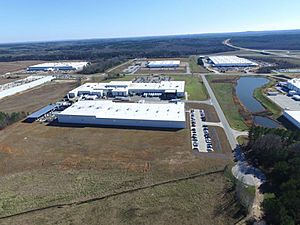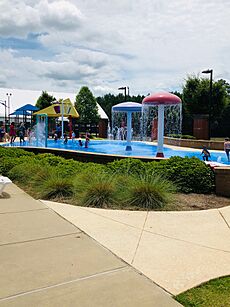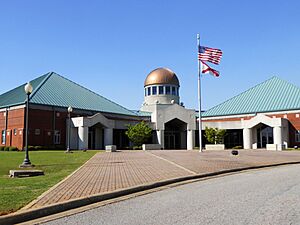Opelika, Alabama facts for kids
Quick facts for kids
Opelika, Alabama
|
|
|---|---|
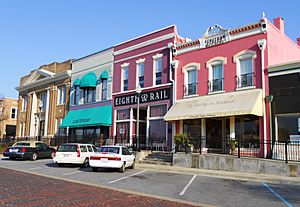
Downtown Opelika
|
|
| Motto(s):
"Rich in Heritage With a Vision for the Future"
|
|
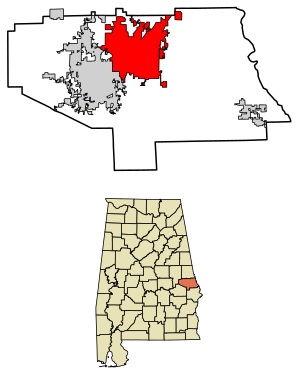
Location of Opelika in Lee County, Alabama
|
|
| Country | United States |
| State | Alabama |
| County | Lee |
| Area | |
| • City | 62.16 sq mi (161.00 km2) |
| • Land | 61.15 sq mi (158.39 km2) |
| • Water | 1.01 sq mi (2.62 km2) |
| Elevation | 807 ft (246 m) |
| Population
(2020)
|
|
| • City | 30,995 |
| • Density | 506.84/sq mi (195.69/km2) |
| • Metro | 150,933 |
| Time zone | UTC-6 (Central (CST)) |
| • Summer (DST) | UTC-5 (CDT) |
| ZIP codes |
36801-36804
|
| Area code(s) | 334 |
| FIPS code | 01-57048 |
| GNIS feature ID | 0152814 |
Opelika (pronounced OH-pə-LY-kə) is a city in Lee County, Alabama. It is the county seat, meaning it's where the county government is located. Opelika is in the east-central part of the U.S. state of Alabama. It is a main city in the Auburn-Opelika Metropolitan Area. In 2020, Opelika had a population of 30,995 people. This was a 17.1 percent increase from 2010. The larger Auburn-Opelika area has about 150,933 residents.
Contents
History of Opelika
The first white settlers came to this area in the late 1830s. They started a community called Lebanon. After native Creek (Muscogee) people were moved by federal troops in 1836-37, the area became known as "Opelika." This name comes from the Muskogee language. It means "large swamp." Not many people lived here until the late 1840s. That's when the railroad arrived. The railroad helped Opelika grow into a busy trading center.
In 1848, the Montgomery & West Point Railroad Company built a rail line to Opelika. By 1851, it connected Opelika to West Point, Georgia. This linked Opelika with Atlanta, Georgia. This railroad was the only direct route between New Orleans and the Eastern Seaboard. It quickly became a major way to ship raw cotton from Southern farms to the North. Soon, another rail line connected to Columbus, Georgia in 1855. A connection to Birmingham, Alabama followed in 1869. Opelika quickly became an important hub for trade.
To manage this fast growth, Opelika became an official town on February 9, 1854. At that time, it was part of Russell County. Because of its many train lines, Opelika built many warehouses. These stored cotton and other goods. During the Civil War, these warehouses were used by the Confederate army. In 1864 and 1865, Union troops attacked Opelika. They damaged the railroads and destroyed government buildings, including the warehouses.
After the war, the Alabama state government created a new county. It was made from parts of other counties. This new county was named Lee County, after a Confederate general. In 1866, people in Lee County voted for Opelika to be their county seat. The town had lost its official status for helping the rebellion.
Opelika received a new official status in 1870. After this, it grew quickly again. The town almost doubled in size between 1870 and 1900. During this time, Opelika faced challenges with its rapid growth. In 1882, there were disagreements about who should lead the city government. This led to some conflict. To restore order, the state government stepped in. They appointed commissioners to manage the city until 1899. That year, the city's official status was fully restored.
Opelika: 1900 to Today
In 1900, local investors started the Opelika Cotton Mill. It was the city's first textile factory and employed 125 people. Opelika was a good place for factories because it had water power. More textile factories were built over the next 30 years. In 1925, city officials helped bring the Pepperell Manufacturing Co. (now WestPoint Home) to build a large mill nearby. From 1930 to 1970, Opelika continued to grow as an industrial center. It became a strong economic area.
In the 1950s, Opelika attracted the country's first and largest magnetic tape factory. In 1963, the tire company Uniroyal built a huge factory in Opelika. Around the same time, Diversified Products made fitness equipment in its Opelika plant. By the early 1970s, Opelika's industries employed nearly 10,000 people.
Between the late 1970s and 2005, jobs in the Auburn-Opelika area grew slowly. Manufacturing jobs changed the most. Many jobs moved to other countries, causing a decline. But this trend has changed. The number of manufacturing jobs has been rising steadily since 2002.
In the late 1990s, Opelika bought and developed the Northeast Opelika Industrial Park. This park is 2,200 acres (8.9 km²) large. It was created to attract more businesses. The city spent about $32 million on the land and development. Since 1999, many big companies have moved into the park. These include large distribution centers, car part suppliers, and Pharmavite. Pharmavite is a top company for making dietary supplements. Car companies like Audi, Nissan, and Hyundai have also shown interest in the park. In 2003, the park was called one of the "South's Best Automotive Assembly Plant Sites."
Opelika has also seen a big increase in retail stores. TigerTown is a large shopping area. It covers 130 acres (0.53 km²) and has over 1,000,000 square feet (93,000 m²) of retail space. It is the biggest shopping center in east Alabama. TigerTown has more than 70 businesses. These include The Home Depot, Target, Best Buy, Starbucks, and many more.
Opelika's biggest employer is the East Alabama Medical Center. In 2009, it paid about $119 million in salaries and benefits. It employed over 2,700 people.
Historic Downtown Opelika has been improved. It is now part of the national Main Street, Inc. program. The downtown area is listed on the National Register of Historic Places. It has many unique shops, art galleries, antique stores, and restaurants.
With more industry and shops, Opelika's population has grown. From 2000 to 2010, Opelika's population increased from 23,638 to 26,617.
Geography of Opelika
Opelika is in the north-central part of Lee County. It is next to Auburn to the west. Opelika is located in the southern part of the Piedmont Plateau. It is also on the line between the Tallapoosa and Chattahoochee river areas. Opelika is about 812 feet (247 meters) above sea level.
Opelika is located at 32°38′50″N 85°23′22″W / 32.647183°N 85.389404°W.
The United States Census Bureau says the city has a total area of 53.4 square miles (138 km²). Of this, 52.8 square miles (137 km²) is land. Only 0.7 square miles (1.8 km²) is water.
Population of Opelika
| Historical population | |||
|---|---|---|---|
| Census | Pop. | %± | |
| 1880 | 3,245 | — | |
| 1890 | 3,703 | 14.1% | |
| 1900 | 4,245 | 14.6% | |
| 1910 | 4,734 | 11.5% | |
| 1920 | 4,960 | 4.8% | |
| 1930 | 6,156 | 24.1% | |
| 1940 | 8,487 | 37.9% | |
| 1950 | 12,295 | 44.9% | |
| 1960 | 15,678 | 27.5% | |
| 1970 | 19,027 | 21.4% | |
| 1980 | 21,896 | 15.1% | |
| 1990 | 22,122 | 1.0% | |
| 2000 | 23,498 | 6.2% | |
| 2010 | 26,477 | 12.7% | |
| 2020 | 30,995 | 17.1% | |
| U.S. Decennial Census 2018 Estimate |
|||
Opelika's Population in 2020
In 2020, Opelika had 30,995 people. There were 11,866 households and 7,199 families living in the city.
| Race | Num. | Perc. |
|---|---|---|
| White (non-Hispanic) | 14,836 | 47.87% |
| Black or African American (non-Hispanic) | 11,947 | 38.54% |
| Native American | 39 | 0.13% |
| Asian | 692 | 2.23% |
| Pacific Islander | 14 | 0.05% |
| Other/Mixed | 1,060 | 3.42% |
| Hispanic or Latino | 2,407 | 7.77% |
Opelika's Population in 2010
In 2009, the average income for a household in Opelika was $35,243. For a family, the average income was $47,864. The average income per person in the city was $18,023. About 23.1% of the population had incomes below the poverty level. This included 31.1% of children and 14.9% of people aged 65 or older.
Opelika's Economy
Opelika's economy is growing and diverse. Since 2004, many parts of the economy have improved. This includes businesses, homes, and industries. Over the last 20 years, since 2005, the city has announced new businesses and expansions. These have brought over $2.6 billion in investments. They have also created more than 4,700 new jobs.
Currently, East Alabama Health is Opelika's largest employer. It has more than 3,700 employees.
Arts and Culture in Opelika
In 2021, the city opened the Opelika Public Library. It is the only public library in the city. The library has a large main area for books. It also has special rooms for teens and kids. There are quiet study rooms and places to work. The library also hosts fun activities for families and teens.
Opelika Community Theatre has been active since 2015. It puts on several shows each year. These shows include plays for both teen and adult actors.
Parks and Recreation in Opelika
Spring Villa Park is a 350-acre (140 ha) park in Opelika. It has picnic areas, playgrounds, nature trails, and camping spots. Spring Villa, an old house in the park, is listed on the National Register of Historic Places.
In 2019, the city opened the Opelika Pickleball Facility. It has 24 courts for playing pickleball.
In 2009, the City of Opelika built the Opelika SportsPlex and Aquatics Center. This facility cost $32 million.
The RTJ Golf Trail at Grand National is in Opelika. It is part of the Robert Trent Jones Golf Trail. This golf course has hosted national championships.
Education in Opelika
Opelika City Schools is the public school system for Opelika. The system has eight schools. There are three primary schools for Kindergarten through 2nd grade. Three intermediate schools serve grades 3-5. There is one middle school for grades 6-8. And one high school, Opelika High School, for grades 9-12.
A campus of Southern Union State Community College is also in Opelika. This is a public, two-year college.
Media in Opelika
Opelika is part of the Columbus, Georgia media market. The Opelika-Auburn News is the city's newspaper.
The movie Norma Rae (1979) was filmed in Opelika.
Transportation in Opelika
- U.S. Route 29
- U.S. Route 280
- U.S. Route 431
- Alabama State Route 14
- Alabama State Route 51
- Interstate 85
Lee-Russell Public Transit offers a ride service called "dial-a-ride." This service is available throughout Opelika and the nearby area.
The last passenger train service was the Illinois Central Railroad's City of Miami. It stopped running in 1971. Another train, the Illinois Central's Seminole, served Opelika until 1969. New Amtrak train service is being planned for the future.
See also
 In Spanish: Opelika (Alabama) para niños
In Spanish: Opelika (Alabama) para niños


